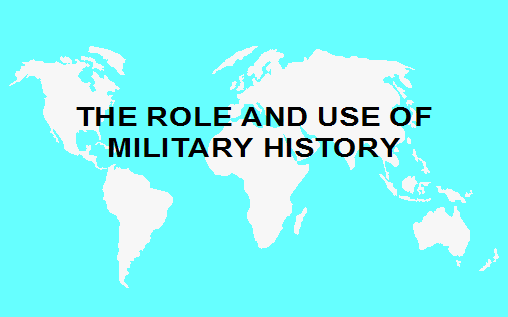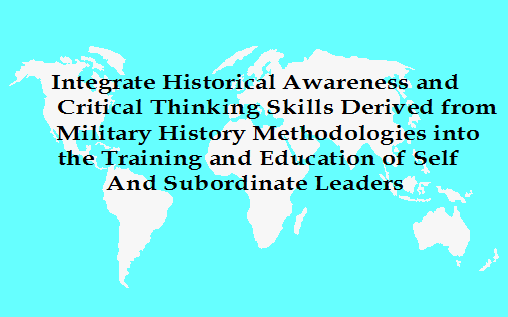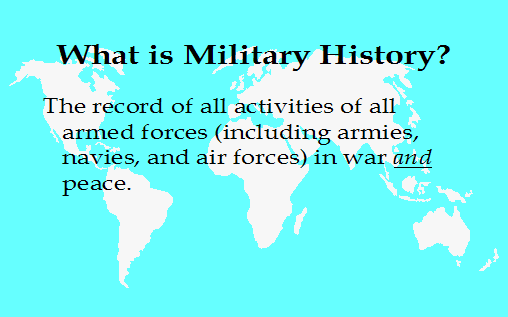The Role and Use of Military History
Click here to download the presentation.



THE ROLE AND USE OF MILITARY HISTORY
What is Military History?
The record of all activities of all armed forces (including armies, navies, and air forces) in war and peace.
WHY DO YOU STUDY MILITARY HISTORY?
HOW DO YOU STUDY MILITARY HISTORY?
VERY CAREFULLY AND METHODICALLY
Activities Included in the Study of Military History
Battles & Campaigns
Strategy & Tactics
Doctrine & Training
Organizations
Logistics
Military & Society
Weapons & Technology
Military Leaders
STUDY CAUSE AND EFFECT
TO DIRECT AND CONTROL FUTURE EVENTS
STUDY: IN WIDTH
OBSERVE EVENTS OVER A LONG PERIOD OF TIME TO OBSERVE CHANGE
STUDY: IN DEPTH
STUDY IN ENOUGH DETAIL TO GET BEHIND ANY GENERALIZATIONS
Using Military History
Learn from past experience
Understand military concepts
Study lives of soldiers in the past
Understand doctrinal evolution
Broaden knowledge of military subjects
Understand leadership issues
Learn about strategy & tactics
STUDY: IN CONTEXT
ARMIES REFLECT BOTH THEIR ERA AND THEIR SOCIETY
“I am convinced that much more emphasis should be placed on history. The purpose of history is to learn how human beings react when exposed to the danger of wounds or death…” General George S. Patton, Jr.
“Nothing is done in war, except by calculation. Every enterprise should be conducted according to a system. Chance alone can never bring success.” Napoleon
“A man’s greatest pleasure is to defeat his enemies, to drive them before him, to take from them that which they possessed, to see those whom they cherished in tears, to ride their horses, to hold their wives. I forbid you to show mercy to my enemies. Leave nothing but uninhabited ruins, neither a cat nor a dog.”
Genghis Khan
HISTORY SHARPENS JUDGMENT
Critical Thinking Skills-
Based on Study of Operational Military History
HISTORY IMPROVES PERCEPTION
Critical Thinking Skills-
Based on Study of Institutional Military History
HISTORY BROADENS PERSPECTIVES
Critical Thinking Skills-
Based on Study of Biographical Military History
Misusing Military History
History provides understanding, not proof.
History provides insight, not analogy.
METHODOLOGIES
The Ten Threads of Continuity.
Battle Analysis.
TEN THREADS OF CONTINUITY
19TH CENTURY
1800—-1850—–1899
Military Theory & Doctrine —–+——————————————>
Military Professionalism———-+——————————————>
Generalship————————-+——————————————>
Strategy——————————+——————————————>
Tactics——————————-+——————————————>
Logistics—————————–+——————————————>
Technology————————–+—————————————–>
Political Factors———————+—————————————–>
Social Factors————————+—————————————–>
Economic Factors——————-+—————————————–>
Military Theory & Doctrine
Ideas about War.
Doctrine = Generally accepted body of practices that govern Organization, Training, and Fighting.
Military Theorists: Those who THINK deeply about war and INFLUENCE others. They SEEK solutions, CREATE frameworks & ADVANCE new concepts.
Military Doctrine
PROVIDES THE BRIDGE BETWEEN THE CONCEPT OR IDEA AND THE ACTUAL APPLICATION OF THE IDEA
Military Professionalism
Attitude or state of mind.
Military professional is an expert in the management of violence.
Functions of the professional army include organizing, equipping, training, planning and directing forces, in and out of combat.
Military Professionalism
Military Professionals share a body of specialized knowledge.
The study of Military History is essential to Military Professionalism.
Defined in Samuel Huntington’s The Soldier and the State.
Expertise:
Responsibility:
Corporateness :
Generalship
Art of command high levels.
Functions include Forming, Organizing, Equipping, and Training armies and/or major portions of them.
Involves the detailed Strategical, Tactical and Logistical planning to insure success of the mission. Entails Leadership and Management.
Strategy
Preparation for and the waging of war.
Dynamic in nature and has evolved with the complexities of weapon technology.
Grand Strategy: Coalition level
National Strategy: Similar to Grand
Military Strategy: Derived from National.
Tactics
The Preparation and actual conduct of Combat on the battlefield.
The employment of units in combat , the ordered arrangement and maneuver of units in relation to each other to utilize their full potential.
Close connection with Technology, Logistics and Strategy.
Logistics & Administration
Supply, Transportation, Evacuation and Hospitalization, Service and Personnel Management.
Relationship between the state’s Economic capacity and its capability for supporting military forces.
In the last century has developed into one of the dominant factors of warfare.
Technology
The Application of science to war.
Accounts for new weapons and the entire range of new equipment.
The Industrial Revolution caused whole chains of technological advances in the fields of weapons, transportation, communication, construction and medicine.
Political Factors
Characteristic elements or actions of governments that affect warfare.
Provide the forces and trends that shape warfare and the goals for which wars are fought.
Difficult to distinguish the military objective from the political goal. Often political goals drive military goals.
Social Factors
Human relationships that affect warfare are social factors.
Includes concepts, such as, popular attitudes, revolution, militarism, psychological warfare, amd combat psychology.
Combatants have aimed at inflicting Total War on a nation’s people.
Economic Factors
Elements that affect warfare, such as, Production, Distribution, and Consumption of the resources of the state.
Economic warfare possible through blockade.
Different types of economies affect warfare.
Interrelationship of Factors
Political, Social and Economic Factors are all interrelated.
They are so complex that studying each one separately is impossible.
These forces provide the foundation of national power.
TIDY SOLUTIONS TO BATTLE ON COMPUTER PRINTOUTS IS A DELUSION- HISTORICALLY ALL WARS WERE VERY UNTIDY.
MILITARY HISTORY PROVIDES THE ARMY’S INSTITUTIONAL MEMORY.
MILITARY HISTORY PROVIDES A GUIDE TO HOW TROOPS BEHAVE IN BATTLE.
THE PRINCIPLES OF WAR PROVIDE A SENSE OF DIRECTION.
MILITARY HISTORY REVEALS THE PATTERNS, TRENDS & RELATIONSHIPS NECESSARY FOR THE DEVELOPMENT OF DOCTRINE.
DOCTRINE PROVIDES THE BRIDGE BETWEEN THE CONCEPT OR THEORY AND THE APPLICATION OF THAT THEORY.
THE ROLE OF MILITARY HISTORY IS TO PROVIDE A METHOD TO LOOK BACK IN ORDER TO LOOK AHEAD.
TASK
Integrate Historical Awareness and Critical Thinking Skills Derived from Military History Methodologies into the Training and Education of Self and Subordinate Leaders.
TERMINAL LEARNING OBJECTIVE
Apply knowledge of military history and battle analysis to the professional development of self and subordinate leaders.
Role and Use
LTG George S. Patton, Jr.:
“To be a successful soldier, you must know history.”
Role and Use
Learn from past experience
Understand military concepts
Study lives of soldiers in the past
Understand doctrinal evolution
Broaden knowledge of military subjects
Understand leadership issues
Learn about strategy & tactics
Basic Battle Analysis
Military History and the
Conduct of Battle
Basic Battle Analysis
What is Battle Analysis?
A method used by the U.S. Army to provide a systematic approach to the study of battles, campaigns, and other operations.
Basic Battle Analysis
Define the subject.
Set the stage.
Describe the action.
Draw lessons and insights.
Basic Battle Analysis
Battle Analysis:
Step 1 — Define the Subject
Basic Battle Analysis
Pick a subject appropriate to the level of operations of interest.
Select a topic related to the types of lessons desired.
Basic Battle Analysis
Quantity and type of sources (books, articles, and other).
Quality of sources (content, bias, and intent).
BATTLE ANALYSIS
METHODOLOGY
STEP I
EVALUATE THE HISTORICAL RESOURCES
Determine the research sources
Evaluate the research sources
Basic Battle Analysis
Battle Analysis:
Step 2 — Set the Stage
Basic Battle Analysis
Type of conflict.
Objectives of the principal antagonists.
Military systems.
Previous experience of forces.
Basic Battle Analysis
Context
Objectives
Additional factors (alliances, tactics, doctrine, and personalities)
Basic Battle Analysis
Alternatives
Area of Operations
Weather
Terrain
Basic Battle Analysis
Basic Battle Analysis
State missions of opposing forces
Describe initial disposition of forces
Describe opening moves
Detail major phases
State outcome
Basic Battle Analysis
Why did events turn out the way they did?
What is relevant about this study to current operations?
Basic Battle Analysis
Who won? Who lost?
What were the constants that affected the outcome?
Basic Battle Analysis
Principles of War
Tenets of Airland Operations
Battlefield Operating Systems
Principles of War
Objective
Offensive
Mass
Economy of Force
Maneuver
Unity of Command
Surprise
Security
Simplicity
Dynamics of Combat Power
MANEUVER
FIREPOWER
PROTECTION
LEADERSHIP
INFORMATION